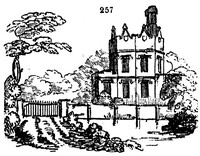1538. With respect to the effects of buildings, as component parts of rural scenery, Shenstone observes, that a landscape, to him, is never complete without a building or rocks; and certainly, considering it merely in the light of a picturesque view, a building, in addition to merely verdant scenery, forms a better picture, by giving a desirable feature or resting-place for the eye. Considered, however, in the light of natural expression, the meanness of root-houses and grottoes, the absurdity of hermits' cells, heathen temples, triumphal arches, mock chapels, &c.; and the inutility of all of them, render them positive deformities in scenes of natural or picturesque beauty. They break in upon repose, simplicity, and all allusion to natural scenery, by their frequency; and suggest ideas of ostentatious vanity in the owner, rather than of propriety and elegance of taste. But though their excess is so general and so obnoxious, some sorts may be occasionally introduced with propriety. Garden-seats are necessary for shade or shelter; bridges, for communication between the banks of rivers or rills; cottages, gate or entrance lodges (fig. 257.), as abodes for labourers; and open sheds as places of resort for cattle. Even a prospect-tower is a desirable object in a flat-country, affording no other means of obtaining a bird's-eye view. A temple, after all, is in many cases but a garden-seat; and if beautiful in itself, and judiciously placed, we can see no objection to its introduction in the garden scene of a princely mansion; certainly none to several, where the geometric style is adopted. To raise a monument in memory of a great public character, or consecrate an urn to private friendship or parental memory, can hardly be offensive to any mind. A sundial is both an useful and an agreeable object; and statues and busts, in highly polished scenery, by the contrast in the kind of beauty displayed, recall the mind for a moment, from contemplating the wide range of nature, to admire the hand of art concentrated in a single point. In this view there are various objects of this description admissible in the more polished scenes of gardens, &c., as marble fountains, fragments of antiquity, &c. But when simplicity and natural beauty are the prevailing ideas, all works of art must interfere more or less with those ideas; and unless they can raise up and maintain a more interesting expression, they must be regarded as injurious rather than beautiful.

